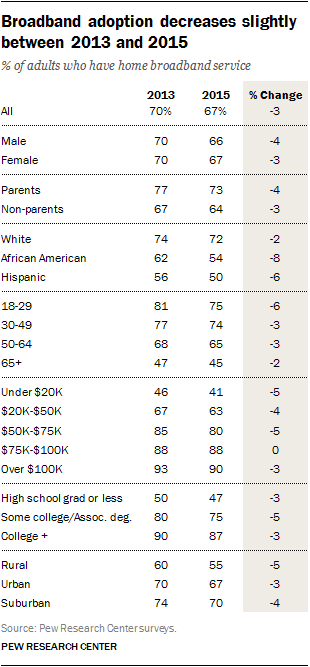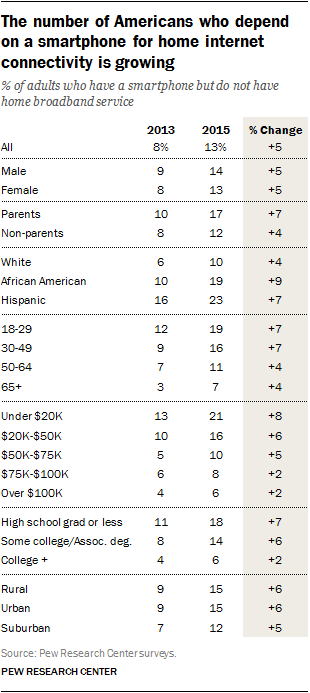
Broadband adoption in the United States has experienced a modest decline in recent years, falling from 70% in 2013 to 67% in 2015. Those figures compare a September 2013 Pew Research Center survey that has a large sample size of 6,010 adults with combined surveys from April, July and November 2015 that total 6,687 adult respondents. These changes in home broadband adoption are concentrated among lower- to middle-income households, rural households and African Americans. There has also been a drop in home broadband adoption among parents of children under the age of 18.
Smartphones keep overall advanced internet access steady, although more Americans are “smartphone-only”
As Pew Research Center surveys have documented, smartphones have rapidly become a staple for many Americans. Our July 2015 survey shows that 68% of Americans now have a smartphone, an increase from 55% two years ago. This increase in smartphone adoption has compensated for the downturn in home broadband adoption in two ways:
- More Americans are more likely to have both means of online access (in other words, a smartphone as well as home broadband service) than was the case two years ago. As of July 2015, 55% of adults report having both a smartphone and a home broadband subscription, up from 47% in 2013.
- More Americans are “smartphone-only” in 2015 than was the case in 2013. Today 13% of adults rely on their smartphone for online access at home (that is, they have a smartphone but no home broadband subscription), compared with 8% in 2013.

The consequence is that the “advanced internet access” picture, which we define as having either a smartphone or a home broadband subscription, has changed little between 2013 and 2015. Today 80% of American adults have either a smartphone or a home broadband connection, a small change from 2013, when 78% had one of these two access means.1
The increase in “smartphone-only” adoption mirrors the decline in home broadband adoption
The increase in the “smartphone-only” phenomenon largely corresponds to the decrease in home broadband adoption over this period. The rise in “smartphone-only” adults is especially pronounced among low-income households (those whose annual incomes are $20,000 or less) and rural adults. African Americans, who saw a marked decline in home broadband adoption, also exhibited a sharp increase in “smartphone-only” adoption (from 10% to 19%), as did parents with school-age children (from 10% in 2013 to 17% in 2015).
Previous Pew Research Center surveys have explored various challenges that the “smartphone-dependent” face. In particular, those who have smartphones only or have limited online access options tend to be younger, lower-income, and are more likely to be non-white. They also are more likely than other users to run up against data-cap limits that often accompany smartphone service plans, and more frequently have to cancel or suspend service due to financial constraints.
The increase in “smartphone-only” adoption, along with the corresponding decline in home broadband subscriptions, captures two facets of contemporary society: rapid innovation in the information technology space and stagnant household incomes. The rate of adoption of smartphones since the introduction of the iPhone in 2007 has been striking. It has taken about half the time for smartphone adoption to double from one-third of adults to two-thirds than was the case for broadband – which was also a technology adopted by Americans at very rapid pace.2
At the same time that innovation in information technology has transformed people’s communications patterns in the past decade, household incomes have declined relative to year 2000 levels, according to a new analysis by Pew Research Center. Notwithstanding some gains in recent years, U.S. median household income in 2014 was still below its level at the start of the Great Recession in 2007. The losses were greatest among lower- and middle-income households in which nearly 8-in-10 American adults reside. Given the role that affordability of service plays in people’s choice to forgo a home broadband subscription (see Section III below), strained household budgets may play a role in the drop in high-speed subscriptions. Smartphones help fill the access gaps for some of these households, particularly as people increasingly see home broadband access as crucial in a variety of areas.




